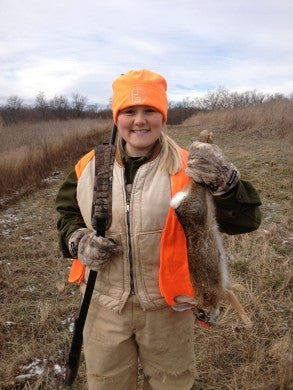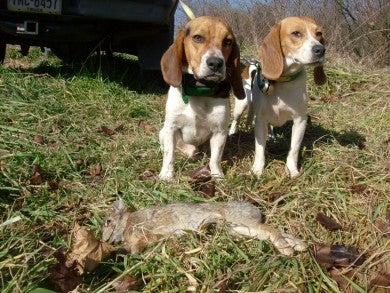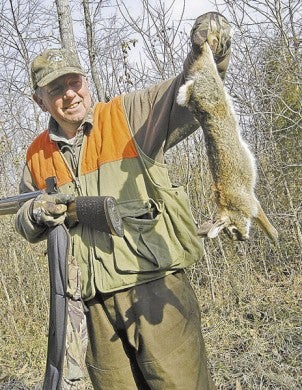Try Tennessee For Cottontails
Bob McNally 12.17.15
Booorrrooo!!
Booorrrooo!!
Ah, sweet music!
The trio of beagles had jumped a rabbit and they were singing in tune, perfect three-part harmony. The crooning canines were the center of attention for our group of hunters. All of us were excited, especially my eldest son Eric, who was enjoying the beagle-bunny chase like only a beginner can on a first-rate rabbit hunt.
The beagles burrowed into a long hedgerow along a cotton field perimeter, while we fanned out on both sides of the brush waiting for a rabbit to make its move. The floppy-eared beagles bored through little holes in the brush, noses tight to the ground and white-tip tails wagging furiously.
“There he goes!!” shouted Tommy Akin. “Comin’ your way Eric, be ready with that 20-gauge!”
Seconds passed, as the hounds yipped and yelled. The tension built as every hunter knew the rabbit soon would bust out of the cover and into the open, with the beagles hot on its trail.
Suddenly there was a shot, then a second report, and the beagles became silent.
“There were two of ’em,” yelled Eric loud and proud. “I got ’em both!!”
I’d forgotten how much fun a rabbit hunt with feisty beagles can be, especially where there are so many rabbits they seem to be hiding under every bush. And that’s just the way it was on that late December hunt to West Tennessee. From the moment the hunt began at dawn until sunset that afternoon there was virtually non-stop, frenzied baying. The dogs went straight, and left, and right, and back…and then around again…while the thickets and field edges we walked exploded with rabbits.
Long brown ears and bobbing bundles of fur popped up everywhere. It was a symphony of beagle music tinged with excitement as I watched my son become an addicted rabbit runner, while his beagle buddies yipped and yodeled, barked and bayed the whole while.
Frequently the hounds would be running two, and sometimes three rabbits simultaneously. Often we’d shoot two or three rabbits that were simply trying to get out of the way of the rabbit chase the hounds had underway.
At day’s end we’d taken plenty of cottontails, and I’d rekindled memories of red hot bunny busting I hadn’t experienced since I was a youngster chasing them all over Illinois, Indiana and Wisconsin corn fields.
“There are so many rabbits in west-central Tennessee it’s incredible,” says Stan Anderson, one of the veteran rabbit runners from Friendship, Tennessee I hunted with. “I don’t think it’s part of a ‘cycle’ in rabbit population or anything, ’cause we’ve always had lots of bunnies. My father Earl, me and a few friends hunt rabbits about every other day. That’s 60 days over about a 120-day season. Sometimes we hunt a farm or field more than once, but not often. And there seems no end to the rabbits we find. One year I kept a log and we took 900 cottontails in a single hunting season. Naturally, we give away most of the bunnies we shoot, usually to landowners or friends who love rabbit stew.”
Anderson hunts mainly in Crockett County, near his hometown, which is where I hunted with him. But he says equally good rabbit hunting can be found in Lauderdale, Haywood and Gibson counties. Anderson uses beagle hounds for rabbits, and hunts mostly small, privately-owned farms. He says gunners can easily get access to many small homesteads in the area for rabbit hunting.

We hunted mostly hedgerows between large fields, usually corn, soybeans and cotton. Compared to some rabbit hunts I’ve been on, West Tennessee hunting is easy going. Rarely did we have to bust brush to flush plenty of rabbits, because the fields were “clean” and cottontails were concentrated in fence rows and field-edge ditches.
State small game biologists say there are a number of public hunting areas in West Tennessee where rabbits are numerous.
Several WMAs in Benton County, collectively called the Kentucky Lake WMAs, have good hunting for rabbits, though the public spots are best known for waterfowl. Other recommended spots are: 900-acre Harmons Creek WMA, 2,300-acre Big Sandy WMA, and 3,000-acre Camden WMA.
Reelfoot WMA in Obion County is another good bet for West Tennessee rabbits. A special Reelfoot WMA preservation permit is needed, which is available from area license agents.
Sprawling 70,000-acre Land-Between-The-Lakes WMA is another good spot for cottontails. A LBL permit is required to hunt the area, which can be had through the LBL office in the town of Golden Pond.
Laurel Hill WMA in Lawrence County, and Percy Priest WMA in Rutherford County are other likely hot spots for rabbits. Each of these WMAs has 14,000 acres open to public hunting.
Shotgunners can pursue cottontails from mid-November through February, with a daily limit of five. With as many rabbits and few hunters as there are in West Tennessee, sportsmen who don’t mind walking a bit have little trouble taking a limit of bunnies—especially if they have some beagle buddies along for the hunt.
Booorrrooo!!
Booorrrooo!!

